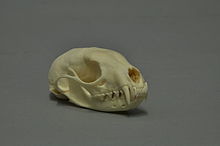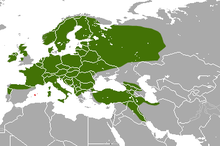Pine marten
| Pine marten | ||||||||||||
|---|---|---|---|---|---|---|---|---|---|---|---|---|

Pine marten |
||||||||||||
| Systematics | ||||||||||||
|
||||||||||||
| Scientific name | ||||||||||||
| Martes martes | ||||||||||||
| ( Linnaeus , 1758) |
The pine marten or noble marten ( Martes martes ) is a species of predator belonging to the genus of the real marten within the family of the marten (Mustelidae). He lives in Europe and West Asia and is a forest dweller. Unlike its relative, the stone marten , the pine marten does not follow people near the settlements.
description

The fur of the pine marten is chestnut to dark brown in color, the throat patch is yellowish brown and rounded downwards and not white and forked like the stone marten . The winter coat is long and silky, in summer his hair is shorter and coarser. Like many martens, it has an elongated body with relatively short legs, and the soles are very hairy. The tail is relatively long and bushy, it serves as a balance organ when climbing and jumping. The head is characterized by the triangular, yellow-rimmed ears, the nose - unlike that of the stone marten - is dark. The head body length of these animals is 45 to 58 centimeters, the tail is 16 to 28 centimeters long. Their weight is 0.8 to 1.8 kilograms. Males become up to a third heavier and also slightly larger than females.
distribution and habitat
Pine marten are native to large parts of Europe and Western Asia. Their distribution area extends from the British Isles to western Siberia , in the south to the Mediterranean islands and in the south-east to the Caucasus and the Elburs Mountains . It is absent in Iceland , in northern Scandinavia and in parts of the Iberian Peninsula . Its habitat are the forests, mainly deciduous and mixed forests. Sometimes he can also be seen in large parks. In the North German Plain , for example in the Münsterland , the pine marten also uses very small field trees and wall hedges as habitat. In the mountains you can find it up to the tree line.
Way of life
Pine marten are tree dwellers to a greater extent than other representatives of the real marten. They can climb and jump very well, being able to overcome up to four meters. When climbing, they are able to turn their feet 180 degrees. They create a few nests in their territory, primarily in tree hollows, but sometimes also in abandoned squirrel cobbles or birds of prey nests . They retire to these resting places during the day, and go in search of food at dusk and at night.
Pine marten are territorial animals that mark their territory with secretions from their anal and abdominal glands. They defend their territorial boundaries against same-sex conspecifics, but the territory of one male can overlap with that of several females. The territory size is very variable, but that of the males is always larger than that of the females. Seasonal differences can also be observed, for example the territories are up to 50 percent smaller in winter than in summer.
food
Pine marten are omnivores , but prefer small mammals (such as voles , rats , shrews and squirrels ) as well as birds and their eggs. But they also eat reptiles , frogs , snails , insects and carrion. Fruits, berries and nuts can make up part of their diet, especially in late summer and autumn. The pine marten kills its prey by biting the neck, and in late summer and autumn it also stores food supplies for the cold season.
Reproduction
Mating takes place in midsummer, but the gestation period is usually postponed so far due to a delay in germination that the young are not born until April. Their development is similar to that of the stone marten : Young pine marten are about ten centimeters long at birth. Usually there are three young in the litter. They stay in the nest for eight weeks before starting to climb around. At 12 to 16 weeks they are independent, but sometimes stay with their mother until next spring. In the second year of life, at around 14 months, they become sexually mature, but often only reproduce in the third year of life. Pine marten can live up to sixteen years of age, but most often die before the age of ten in the wild.
Despite their great external similarity, there are probably no crosses between tree martens and stone martens.
Man and pine marten
The name “noble marten” comes from the fact that its fur used to be much more sought after than that of the stone marten. Due to the fur hunt, the species has become rare in some areas, but due to its relatively large distribution area it is not yet one of the threatened species. The problem, however, is that the species needs large, well-structured forest areas and has therefore disappeared from many areas.
literature
- Carl Zeiß, Fritz Dobschova: Lexikon der Waidmannssprache , Vienna 1992, p. 29, ISBN 3-7039-0011-3
- Ilse Haseder , Gerhard Stinglwagner : Knaurs Großes Jagdlexikon , Augsburg 2000, p. 524 ISBN 3-8289-1579-5
- Jan Ole Kriegs, Nikolai Eversmann, Hans-Ulrich Hachmann, Manfred Lindenschmidt, Thorsten Pickel, Heinz-Otto Rehage (2012): A method for mapping the pine marten Martes martes (Linnaeus, 1758) using the example of the Westphalian Bight. Nature and Homeland 72 (4): 107–116.
Web links
- Martes martes in the endangered Red List species the IUCN 2008. Posted by: A. Wreath &. a., 2008. Retrieved January 1, 2009.
- More pictures and information in the nature dictionary
- waldwissen.net : Pine marten: secret hunters in the crown area of the forest
Individual evidence
- ↑ Fritz Schmidt: The martens and their breeding . Akademische Verlagsanstalt, Leipzig 1951, pp. 13–15.


